Capital Not specified Established 1914 | Historical era World War I Disestablished 1918 | |
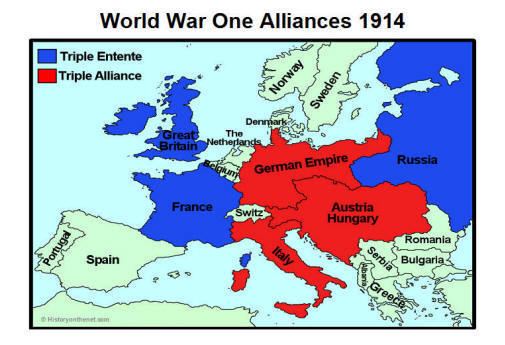 | ||
The Allies of World War I were the countries that opposed the Central Powers in the First World War.
Contents
- History
- War justifications
- Colonies and dependencies
- Russia
- France
- Japan
- Italy
- Serbia
- Romania
- Belgium
- Brazil
- Montenegro
- Nejd and Hasa
- Idrisid Emirate of Asir
- United States
- Non state combatants
- Russia 19141917
- British Empire
- Dominion of Canada
- Commonwealth of Australia
- Empire of India
- Union of South Africa
- New Zealand
- Dominion of Newfoundland
- Italy 19151918
- Romania 19161918
- Greece 19171918
- United States 19171918
- Portugal 19171918
- Siam Thailand 19171918
- Brazil 19171918
- Armenia 1918
- Personnel and casualties
- Summary of Declarations of War
- References
The members of the original Entente Alliance of 1907 were the French Republic, the British Empire and the Russian Empire. Italy ended its alliance with the Central Powers, arguing that Germany and Austria-Hungary started the war and that the alliance was only defensive in nature; it entered the war on the side of the Entente in 1915. Japan was another important member. Belgium, Serbia, Greece, Montenegro, and Romania were affiliated members of the Entente.
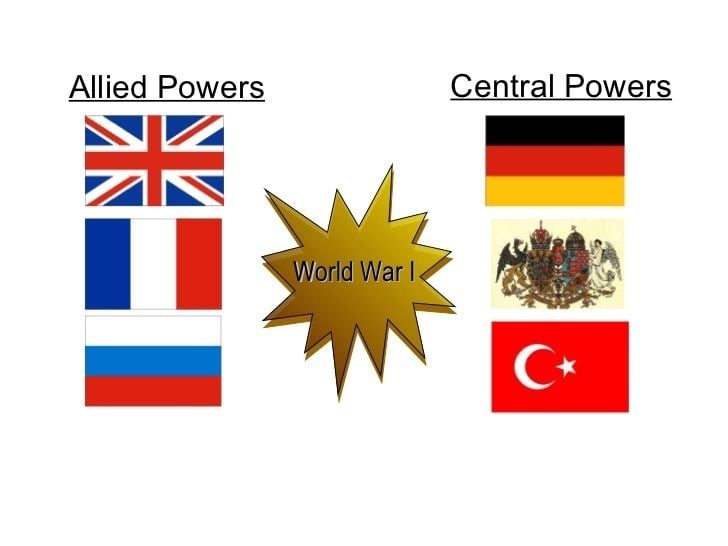
The 1920 Treaty of Sèvres defines the Principal Allied Powers as the British Empire, French Republic, Italy and Japan. The Allied Powers comprised, together with the Principal Allied Powers, Armenia, Belgium, Greece, Hejaz, Poland, Portugal, Romania, Serb-Croat-Slovene state and Czechoslovakia.
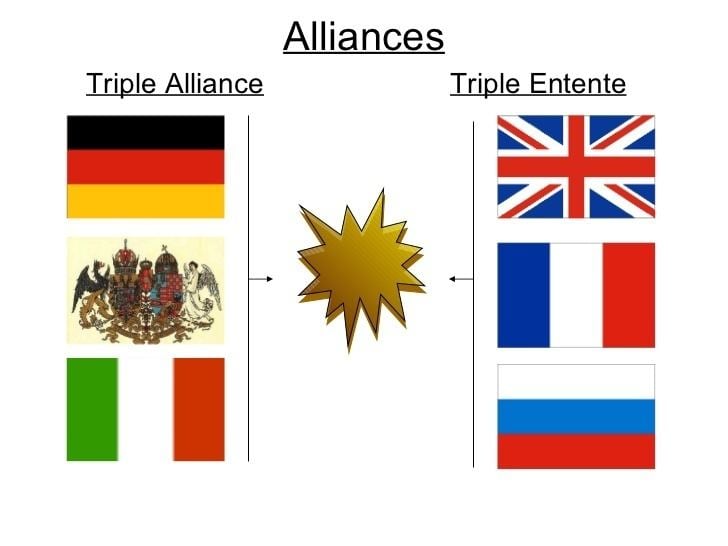
The U.S. declaration of war on Germany in April 1917 was on the grounds that Germany had violated its neutrality by attacking international shipping and the Zimmermann Telegram sent to Mexico. It declared war on Austria-Hungary in December 1917. The U.S. entered the war as an "associated power", rather than as a formal ally of France and the United Kingdom, in order to avoid "foreign entanglements". Although the Ottoman Empire and Bulgaria severed relations with the United States, neither declared war.
The Dominions and Crown Colonies of the British Empire made great contributions to the Allied war effort, but did not have independent foreign policies in World War I with the British War Cabinet exercising operational control of British Empire forces. The Dominion governments did control recruiting, and removed personnel from front-line duties as they saw fit. From early 1917, the War Cabinet was superseded by the Imperial War Cabinet, which had Dominion representation. The Australian Corps and Canadian Corps were placed under the command of Australian and Canadian Lieutenant Generals John Monash and Arthur Currie, respectively, who reported in turn to British generals. In April 1918, operational control of all Entente forces on the Western Front passed to the new supreme commander, Ferdinand Foch of France.
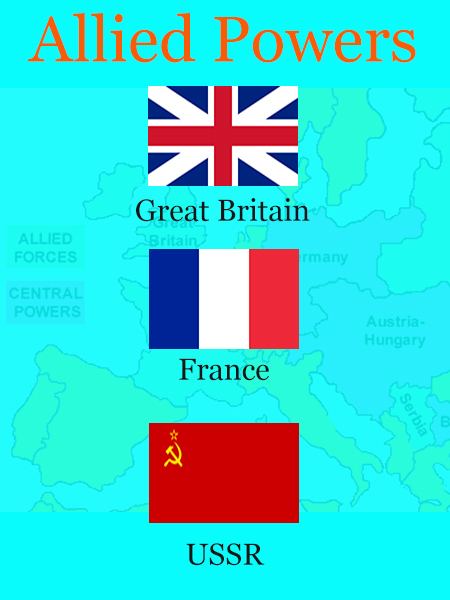
History
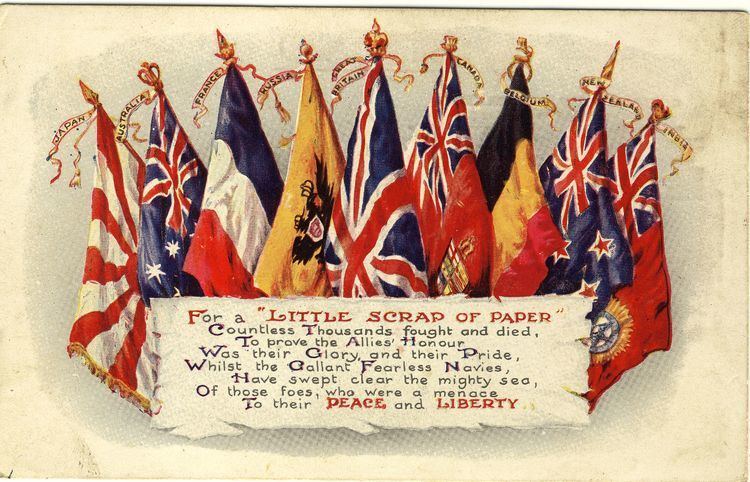
The original alliance opposed to the Central Powers was the Triple Entente, which was formed by three Great European Powers:
The war began with the Austrian attack invasion of Serbia on 28 July 1914, in response to the assassination of Archduke Franz Ferdinand. The Austrian Empire followed with an attack on the Serbian ally Montenegro on 8 August. On the Western Front, the two neutral States of Belgium and Luxembourg were immediately occupied by German troops as part of the German Schlieffen Plan.
Of the two Low Countries involved in the war, Luxembourg chose to capitulate, and was viewed as a collaborationist state by the Entente powers: Luxembourg never became part of the Allies, and only narrowly avoided Belgium's efforts of annexation, at the conclusion of hostilities in 1919. On 23 August Japan joined the Entente, which then counted seven members.. The entrance of the British Empire brought Nepal into the war.
On 23 May 1915, Italy entered the war on the Entente side and declared war on Austria; previously, Italy had been a member of the Triple Alliance but had remained neutral since the beginning of the conflict. In 1916, Montenegro capitulated and left the Entente, and two nations joined, Portugal and Romania.
On 6 April 1917, the United States entered the war. Liberia, Siam and Greece also became allies. After the October Revolution, Russia left the alliance and ended formal involvement in the war, by the signing of the treaty of Brest Litovsk in November effectively creating a separate peace with the Central Powers. This was followed by Romanian cessation of hostilities, however the Balkan State declared war on Central Powers again on 10 November 1918. The Russian withdrawal allowed for the final structure of the alliance, which was based on five Great Powers:
Following the Versailles conference, Britain, France, Italy and Japan became the permanent members of the League of Nations council. The United States, meant to be the fifth permanent member, left because the US Senate voted on 19 March 1920 against the ratification of the Treaty of Versailles, thus preventing American participation in the League.
War justifications
In response to the Germans invasion of neutral Belgium, the United Kingdom declared war on Germany on 4 August 1914. The British Empire held several semi-autonomous dominions that were automatically brought into the war effort as a result of the British declaration of war, including Australia, Canada, New Zealand, Newfoundland, and South Africa.
Colonies and dependencies
In Europe
Gibraltar, Cyprus and Malta were British dependencies in Europe.
In Africa
The UK held several colonies, protectorates, and semi-autonomous dependencies at the time of World War I. In Eastern Africa the East Africa Protectorate, Nyasaland, both Northern and Southern Rhodesia, the Uganda Protectorate, were involved in conflict with German forces in German East Africa. In Western Africa, the colonies of Gold Coast and Nigeria were involved in military actions against German forces from Togoland and Kamerun. In Southwestern Africa, the semi-autonomous dominion of South Africa was involved in military actions against German forces in German South-West Africa.
In North America
Canada and Newfoundland were two autonomous dominions during the war that made major military contributions to the British war effort.
Other British dependent territories in the Americas included: British Honduras, the Falkland Islands, British Guiana, and Jamaica.
In Asia
The UK held large possessions in Asia, including the Indian Empire which was an assortment of British imperial authorities in the territory now defined as India, Bangladesh, Burma, and Pakistan.
Other British territories at the time included: British Malaya – referring to several Malay states under British control as a result of the Straits Settlements, North Borneo, Sri Lanka, and Hong Kong.
In Oceania
Australia and New Zealand were two autonomous dominions of the UK in Oceania during the war. Australia had become an independent nation state in 1901. Having strong cultural ties with the United Kingdom, the nations declared war on Germany on 4 August 1914.
Russia
In response to Austria-Hungary's invasion of Serbia in 1914, Russian government officials denounced the Austro-Hungarian invasion as an "ignoble war" on a "weak country". Russian government official Nikolaĭ N. Shebeko stated: "the attack on Serbia by a powerful empire such as Austria, supposedly in order to defend its existence, cannot be understood by anyone in my country; it has been considered simply as a means of delivering a death-blow to Serbia." Russia held close diplomatic relations with Serbia, and Russian foreign minister Sergey Sazonov suspected the events were a conspiracy between Austria-Hungary and Germany to expel Russian influence in the Balkans. On 30 July 1914, Russia enacted a general mobilization. The day after general mobilization was enacted, Austria-Hungary's ally Germany declared war on Russia prior to expected Russian intervention against Austria-Hungary.
Following a raid by Ottoman warships on the Russian port of Odessa, Russia declared war on the Ottoman Empire in November 1914.
France
After Germany declared war on Russia, France with its alliance with Russia prepared a general mobilization in expectation of war. On 3 August 1914, Germany declared war on France.
Japan
Japan declared war on Germany after it did not accept an ultimatum sent by Japan to Germany, demanding that Germany extinguish its title to the Kiautschou Bay concession and restore that territory to China. The Japanese government appealed to the Japanese public that Japan was not merely entering a "European War" on behalf of European powers, but that Japan was fighting on behalf of Asians against a belligerent European power, Germany, that Japan identified as the "source of evil in the Far East". Thus as a result of this, Japan was following through with the Anglo-Japanese Alliance.
Italy
Italy had been a member of the Triple Alliance alongside Germany and Austria-Hungary since the 1880s, however the Triple Alliance stipulated that all parties must be consulted in the event of one country engaging in war and Italy was not informed of this. As such Italy claimed that it was not obligated to join their war effort. Italy's relations with Germany and Austria-Hungary in contrast to the Allies were additionally affected by the fact that in 1913, Britain supplied Italy with 90 percent of its annual imports of coal. The war effort of the Central Powers meant that Germany and Austria-Hungary were using their coal supplies for the war, and little was available to be exported to Italy. Italy initially attempted to pursue neutrality from 1914 to 1915.
After diplomatic negotiations, Britain and France convinced Italy to join the war effort with promises that Italy would gain favourable territorial concessions from the Central Powers, including Italian-populated territories of Austria-Hungary. Italy ordered mobilization on 22 May 1915, and issued an ultimatum to Austria-Hungary, and then declared war on Austria-Hungary, though it did not declare war on Germany.
Serbia
Serbia was invaded by Austria-Hungary after Austria-Hungary placed a stringent ultimatum to the Serbian government demanding full compliance to an Austro-Hungarian investigation of complicity by the Serbian government in the assassination of Archduke Francis Ferdinand. Serbia agreed to most of Austria-Hungary's demands but because it did not fully comply, Austria-Hungary invaded.
Serbia had the diplomatic support of Russia, and both Serbia and Russia resented Austria-Hungary's absorption of Bosnia and Herzegovina that held a substantial Serb population. Serbia had expanded in size through its actions in the Balkan Wars of 1912–1913 when the Ottoman Empire's control in the Balkans collapsed.
During the war, Serbia justified the war as being the result of Austro-Hungarian imperialism towards Serbs and South Slavs, Serbia cooperated with Yugoslavists including the Yugoslav Committee who sought pan-South-Slav unification, particularly through liberating South Slavs from Austria-Hungary. In the Corfu Declaration in 1917, the Serbian government officially declared its intention to form a state of Yugoslavia.
The first two allied victories in the war were won by the Serbian army, on the mountains of Cer and Kolubara, in western Serbia. The Austro-Hungarian army was expelled from the country, suffering heavy losses. Serbia suffered great losses during the war, almost 50% of all men and around 30% of its entire population were killed.
Romania
Equal status with the main Allied Powers was one of the primary conditions for Romania's entry into the War. The Powers officially recognized this status through the 1916 Treaty of Bucharest. Romania fought on 3 of the 4 European Fronts: Eastern, Balkan and Italian, fielding in total over 1,200,000 troops.
Romanian military industry was mainly focused on converting various fortification guns into field and anti-aircraft artillery. Up to 334 German 53 mm Fahrpanzer guns, 93 French 57 mm Hotchkiss guns, 66 Krupp 150 mm guns and dozens more 210 mm guns were mounted on Romanian-built carriages and transformed into mobile field artillery, with 45 Krupp 75 mm guns and 132 Hotchkiss 57 mm guns being transformed into anti-aircraft artillery. The Romanians also upgraded 120 German Krupp 105 mm howitzers, the result being the most effective field howitzer in Europe at that time. Romania even managed to design and build from scratch its own model of mortar, the 250 mm Negrei Model 1916.
Other Romanian technological assets include the building of Vlaicu III, the world's first aircraft made of metal. The Romanian Navy possessed the largest warships on the Danube. They were a class of 4 river monitors, built locally at the Galați shipyard using parts manufactured in Austria-Hungary, and the first one launched was Lascăr Catargiu, in 1907. The Romanian monitors displaced almost 700 tons, were armed with three 120 mm naval guns in 3 turrets, two 120 mm naval howitzers, four 47 mm anti-aircraft guns and two 6.5 machine guns. The monitors took part in the Battle of Turtucaia and the First Battle of Cobadin. The Romanian-designed Schneider 150 mm Model 1912 howitzer was considered one of the most modern field guns on the Western Front.
Romania's entry into the War in August 1916 provoked major changes for the Germans. General Erich von Falkenhayn was dismissed and sent to command the Central Powers forces in Romania, which enabled Hindenburg's subsequent ascension to power. Due to having to fight against all of the Central Powers on the longest front in Europe (1,600 km) and with little foreign help (only 50,000 Russians aided 650,000 Romanians in 1916), the Romanian capital was conquered that December. Vlaicu III was also captured and shipped to Germany, being last seen in 1942. The Romanian administration established a new capital at Iași and continued to fight on the Allied side in 1917. Despite being relatively short, the Romanian campaign of 1916 provided considerable respite for the Western Allies, as the Germans ceased all their other offensive operations in order to deal with Romania. After suffering a tactical defeat against the Romanians (aided by Russians) in July 1917 at Mărăști, the Central Powers launched two counterattacks, at Mărășești and Oituz. The German offensive at Mărășești was soundly defeated, with German prisoners later telling their Romanian captors that German casualties were extremely heavy, and that they "had not encountered such stiff resistance since the battles of Somme and Verdun". The Austro-Hungarian offensive at Oituz also failed. On 22 September, the Austro-Hungarian Enns-class river monitor SMS Inn was sunk by a Romanian mine near Brăila. After Russia signed the Treaty of Brest-Litovsk and dropped out of the War, Romania was left surrounded by the Central Powers and eventually signed a similar treaty on 7 May 1918. Despite being forced to cede land to Austria-Hungary and Bulgaria, Romania ended up with a net gain in territory due to the Union with Bessarabia. On 10 November, Romania re-entered the War and fought a war with Hungary that lasted until August 1919.
Belgium
Belgium had declared its neutrality when the war began, but Germany disregarded Belgium's neutrality and invaded the country in order to launch an offensive against the French capital of Paris. As a result, Belgium became a member of the Allies.
Brazil
Brazil entered the war in 1917 after the United States intervened on the basis of Germany's unrestricted submarine warfare sinking its merchant ships, which Brazil also cited as a reason to enter the war fighting against Germany and the Central Powers.
Montenegro
Montenegro had very close cultural and political connections with Serbia and had cooperated with Serbia in the Balkan Wars of 1912–1913. Montenegro joined the war against Austria-Hungary.
Nejd and Hasa
The Emirate of Nejd and Hasa agreed to enter the war as an ally of Britain in the Treaty of Darin on December 26, 1915.
Idrisid Emirate of Asir
The Idrisid Emirate of Asir participated in the Arab revolt. Its Emir, Muhammad ibn Ali al-Idrisi, signed an agreement with the British and joined the Allies in May 1915.
United States
The United States declared war on Germany in 1917 on the grounds that Germany violated U.S. neutrality by attacking international shipping with its unrestricted submarine warfare campaign. The remotely connected Zimmermann Telegram of the same period, within which the Germans promised to help Mexico regain some of its territory lost to the U.S nearly eight decades before, was also a contributing factor. The U.S. entered the war as an "associated power," rather than a formal ally of France and the United Kingdom, in order to avoid "foreign entanglements." Although the Ottoman Empire and Bulgaria severed relations with the United States, neither declared war.
Non-state combatants
Three non-state combatants, which voluntarily fought with the Allies and seceded from the constituent states of the Central Powers at the end of the war, were allowed to participate as winning nations to the peace treaties:
Serbia
Montenegro
Russia (1914–1917)
Belgium
France
British Empire
Dominion of Canada
Commonwealth of Australia
Empire of India
Union of South Africa
New Zealand
Dominion of Newfoundland
Japan
Italy (1915–1918)
Romania (1916–1918)
Greece (1917–1918)
United States (1917–1918)
Portugal (1917–1918)
Siam (Thailand) (1917–1918)
See main Article: Siam in World War I
Brazil (1917–1918)
See main Article: Brazil during World War I
Armenia (1918)
Personnel and casualties
These are estimates of the cumulative number of different personnel in uniform 1914–1918, including army, navy and auxiliary forces. At any one time, the various forces were much smaller. Only a fraction of them were frontline combat troops. The numbers do not reflect the length of time each country was involved. (See also: World War I casualties)
Summary of Declarations of War
The following table shows the timeline of the several declarations of war among the belligerent powers. Entries on a yellow background show severed diplomatic relations only, not actual declarations of war. Unless stated otherwise, declarations of war by and on the United Kingdom include de facto declarations by and on other members of the British Empire.
